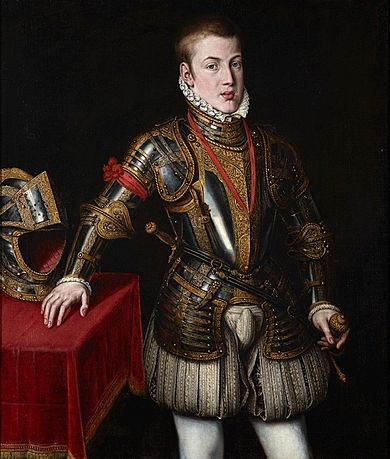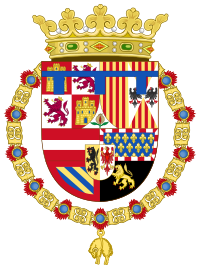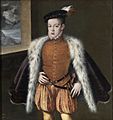Carlos, Prince of Asturias facts for kids
Quick facts for kids Carlos |
|
|---|---|
| Prince of Asturias | |

Portrait by Alonso Sánchez Coello, 1564
|
|
| Born | 8 July 1545 Valladolid, Spain |
| Died | 24 July 1568 (aged 23) Madrid, Spain |
| Burial | El Escorial |
| House | Habsburg |
| Father | Philip II of Spain |
| Mother | Maria Manuela, Princess of Portugal |
| Religion | Roman Catholicism |
Carlos, Prince of Asturias, also known as Don Carlos (born 8 July 1545 – died 24 July 1568), was the oldest son of King Philip II of Spain. This made him the heir apparent, meaning he was next in line to become king. His mother was Maria Manuela of Portugal.
Don Carlos had some serious health issues and was mentally unstable. Because of his unpredictable behavior, his father, King Philip II, had to imprison him in early 1568. Don Carlos died about six months later while in confinement. His sad story became a popular topic in history and inspired famous works like a play by Friedrich Schiller and an opera by Giuseppe Verdi.
Contents
Life of Don Carlos
Carlos was born in Valladolid, Spain, on 8 July 1545. His parents were Philip of Spain and María Manuela of Portugal. They were first cousins. His grandfather, Emperor Charles V, was the king of Spain at the time. Sadly, Carlos's mother, Maria, died just four days after he was born. She passed away from bleeding after giving birth.
The young Prince Carlos was often sick and had some physical differences. As he grew up, he became very proud and stubborn. When he was a young adult, he started showing signs of mental instability. Many of his health problems might have come from the close family relationships common in his family, the House of Habsburg, and the royal families of Portugal and Spain.
Early Years and Education
Since his mother died early, Carlos was raised by his aunts and other family members. People at the time thought Carlos was spoiled, emotionally unstable, and not very smart. He went to school at the Universidad de Alcalá de Henares. He studied there with his uncle Juan of Austria and Alexander Farnese.
Some reports from his time suggest he had serious mental problems. For example, he once ordered a serving girl to be whipped for no clear reason. The Venetian ambassador, Hieronymo Soranzo, described Carlos as "ugly and repulsive." Another visitor, Paolo Tiepolo, wrote that Carlos "wished neither to study nor to take physical exercise, but only to harm others."
However, some historians believe these reports might have been just rumors. Carlos had a large personal library filled with books on Spanish, Aragonese, and Portuguese history. He also had books on math, astronomy, and maps. He even started learning German in 1566. It's not clear if a later accident affected his intelligence.
In 1556, Emperor Charles V gave up his throne. He retired and left the Spanish parts of his empire to his son, Philip, who was Carlos's father. The former emperor died in 1558. The next year, Prince Carlos was supposed to marry Elizabeth of Valois, the daughter of King Henry II of France. But for political reasons, and because his father didn't trust Carlos's temper, Elizabeth instead married King Philip in 1560.
Carlos was always in poor health. When he was 14, he got malaria, which caused problems with his legs and spine. In 1561, doctors suggested he move to Alcalá de Henares permanently because the climate was better for his health. Carlos often complained that his father wouldn't give him important jobs. Finally, the King gave him positions in the Council of Castile and the Council of Aragon. But these were only advisory roles, which made Carlos even angrier. He didn't show much interest in these councils or in learning about political matters.
Becoming Heir and a Serious Accident
After Elizabeth of Valois married his father, three other brides were suggested for Carlos: Mary, Queen of Scots; Margaret of Valois (another French princess); and Anna of Austria. Anna of Austria was later to become Philip's fourth wife. In 1564, it was agreed that Carlos would marry Anna. His father had promised him control over the Low Countries (modern-day Netherlands and Belgium) in 1559. But Carlos's increasing mental instability made his father change his mind, which made Carlos even more furious.
In 1560, when he was 15, Carlos was officially recognized as the heir to the Crown of Castile. Three years later, he was also named heir to the Crown of Aragon. If he had lived until the Portuguese succession crisis happened, he would have had a strong claim to the Portuguese throne. Because he was so important, he often attended meetings of the Council of State, which handled foreign affairs. He also wrote letters to his aunt Margaret, who governed the Low Countries for his father.
In 1562, Carlos had a very serious accident. He fell down the stairs while chasing a serving girl. The prince was close to death, in terrible pain, and having delusions. Doctors tried many different treatments. His life was saved by a surgery on his skull, performed by the famous anatomist Andreas Vesalius. After he recovered, Carlos became even more wild, unstable, and unpredictable. His father had to keep him away from any positions of power. Carlos also disliked the Duke of Alba, who became the commander of Philip's forces in the Netherlands. This was a job Carlos had wanted.
Troubled Behavior and Imprisonment
Carlos's frustration and mental problems were noticed by rebel groups in the Low Countries. In 1565, Carlos secretly met with representatives of these rebels. He planned to escape to the Netherlands and declare himself king with their help. In one of his confused moments, he told his plan to Prince of Eboli, who was loyal to the king and immediately told Philip.
In 1567, the prince showed more signs of mental instability. Once, water accidentally splashed him from a window during a walk. He then ordered the house to be set on fire. He also tried to attack the Duke of Alba in public. He tried to throw a servant out of a high window and also tried to harm a guard who had upset him.
In late 1567, he tried again to flee to the Netherlands. He asked John of Austria to take him to Italy. John was loyal to the king and knew about Carlos's mental state. He asked for 24 hours to think about it, and used that time to tell the king. The king immediately refused permission for the trip.
As a result, Carlos tried to harm John. He loaded his gun and called John of Austria to his room, trying to shoot him. Luckily, one of the servants, knowing the prince's behavior, had secretly unloaded the gun. Carlos became so angry that he tried to attack John with his bare hands. He also told several people at court that he wanted to harm the King. After these incidents, Philip decided to imprison the prince in his rooms. Carlos could not receive letters and had very limited contact with the outside world.
Just before midnight on 17 January 1568, King Philip II, wearing armor, entered Don Carlos's bedroom in the Alcázar of Madrid with four advisors. They announced his arrest, took his papers and weapons, and sealed his windows. Since Carlos threatened to take his own life, the king made sure he had no knives or forks in his room.
Death of Don Carlos
When explaining the situation to the public and other European countries, Philip tried to explain his son's absence without revealing his exact problems. He hoped Carlos might recover. This lack of clear information was used by those who opposed the Spanish king, especially William the Silent.
On 24 July 1568, Prince Carlos died in his room. It is believed he died because of his delicate health. His death became a key part of the Spanish Black Legend in the Netherlands. This was propaganda used to justify a revolt against the Spanish king. For a long time, especially in northern Europe, people claimed that King Philip had ordered Carlos to be poisoned. This idea came from the propaganda created in the Netherlands. However, most Spanish and Italian historians always said that evidence showed he died of natural causes. Today, most modern historians agree that Don Carlos died of natural causes due to his ongoing health issues.
Don Carlos in Stories and Art
The story of King Philip imprisoning his own son became a big part of the anti-Spanish Black Legend in places like the Netherlands, Germany, and England. This propaganda led to Friedrich Schiller's famous play Don Karlos, Infant von Spanien in 1787.
Schiller's play was based on a novel from 1672 by a French writer. In these stories, Don Carlos is shown as a noble and brave knight. He is often portrayed as being in love with Elizabeth of Valois, who became his father's wife. They are shown fighting for freedom and their love against a cruel King Philip II. In these fictional versions, the hero is defeated by betrayal because he is too noble.
Schiller's play was turned into several operas. The most famous is Giuseppe Verdi's Don Carlos (1867). This opera is still very popular today. In Verdi's opera, Carlos is shown as a victim of palace plots. His mental instability or violent tendencies are barely mentioned.
The idea of a king jailing his own son also inspired the Spanish play La vida es sueño (Life Is a Dream) (1635) by Pedro Calderòn de la Barca. However, this play doesn't directly mention Don Carlos and has a different main idea, likely inspired by religious thoughts and ancient philosophy.
Don Carlos in Popular Media
- In the TV show Reign (on The CW), Canadian actor Mark Ghanimé plays Carlos. The show includes his brain damage, but changes how it happened.
- Joseph Cuby played Carlos in the TV series Sir Francis Drake (1962) in the episode "Visit to Spain."
Images for kids
-
Portrait of Don Carlos by Alonso Sánchez Coello, 1560
See also
 In Spanish: Carlos de Austria (príncipe de Asturias) para niños
In Spanish: Carlos de Austria (príncipe de Asturias) para niños




